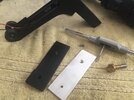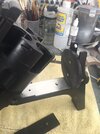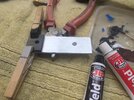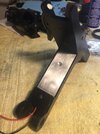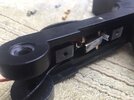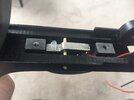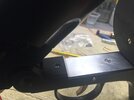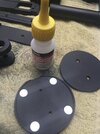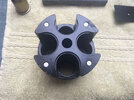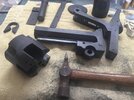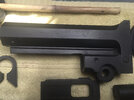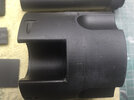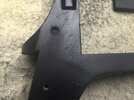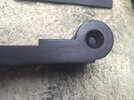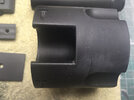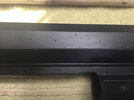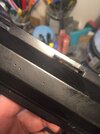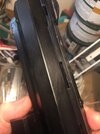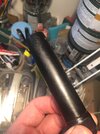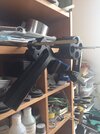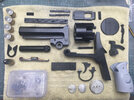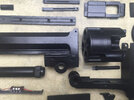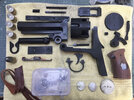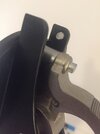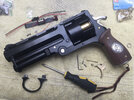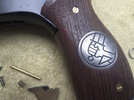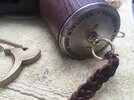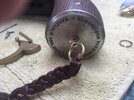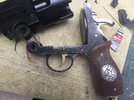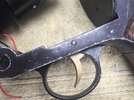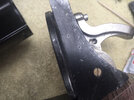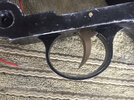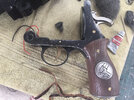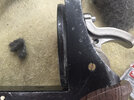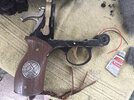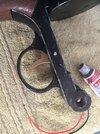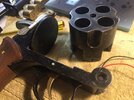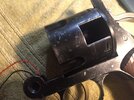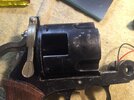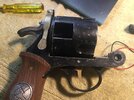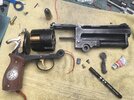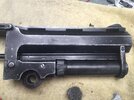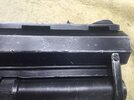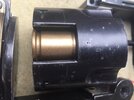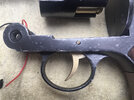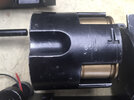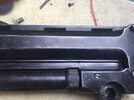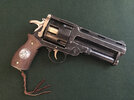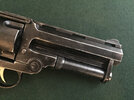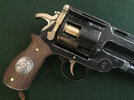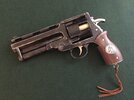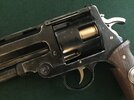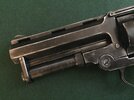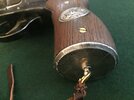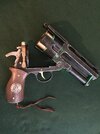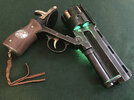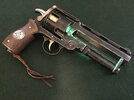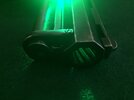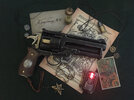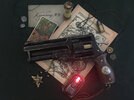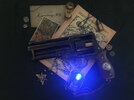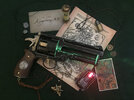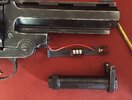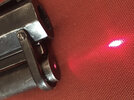wayouteast
Sr Member
I was recently lucky enough to be one of the first people to get their (bright red and differently sized) hands on the new kit of Hellboy’s ‘Good Samaritan’ revolver from the 2004 / 2008 movies by TipTopWorkshop and Anders Pedersen (available on the TipTop Workshop shop and in the Project Runs forum here).
The main parts of the gun are pressure cast resin (black in my case), with smaller details either resin printed or - as a brilliant bonus - cast in pewter. The kit comes with all the hardware - screws, brass pins, springs etc. - needed to assemble the gun, as well as the electronics to create the laser sight and four glowing tracker bullets (all you need to supply is 11 LR44 button cells - 2 for each of the bullets and 3 for the laser). The resin is beautifully cast, with little or no bubbles and requires minimal clean up of excess resin or flash. I started by giving all the parts a really good scrub with household degreaser and soapy water to get rid of any mould-release residue and let them air dry before the small amount of filing, filling and sanding needed to ready them for the next stage. Another quick wash and then a gentle wet-sanding with low grit sand paper finished them off nicely. I left the odd minor imperfection as I knew I was going to be adding damage later!
The picture shows the parts all laid out (I’ve already painted and assembled the bullets - see below).
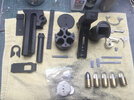
Time for a first dry fit assembly. Damn! This thing is HUGE! (phaser for size reference - in case you assume from the first image that I have a Munchkin size hand)
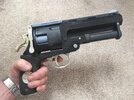
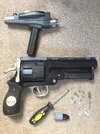
The gun went together really well from the start, although, as you’d expect, there was some adjusting to be done, especially on the resin printed parts. So a bit of sanding and filing was needed at this stage to get the fit of the parts perfect - the tolerances are quite tight, and rightly so. Some experimentation, fitting and re-fitting, and a bit of work is needed to get the cylinder spinning freely, the bullets fitting into the cylinder easily and the various smaller detail parts perfectly attached. Certainly no more than you’d expect from resin printed parts, and all easily accomplished.
I decided to dip a toe into the water of this build by painting the bullets first, and getting their electronics installed. Each bullet comes in four parts, a resin printed casing and a tip that’s cast (really well) in clear resin, plus an internal housing for two LR44 button cells and a micro-switch, and a resin primer. There's also a green 5mm LED for each bullet. The tip and the casing screw together around the battery holder/LED and the primer fits into the casing end to act as an external switch to light the LED. The design of the internal housing is really very clever and you can put it all together without even having to use solder or wires, using the clear instructions that come with the kit. I opted to add a little bit more strength to mine by soldering the joints, and I ended up glueing the primers to the switches too for extra durability (I didn't want to lose the primers at any point!
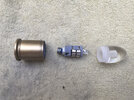
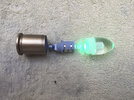
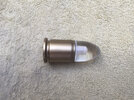
I primed the casings and the primers, sprayed them both satin black, and then airbrushed Alclad Polished Brass over the casings and ’Stainless Steel’ on the primers.
Voila - four beautiful green glowing tracker rounds. I also painted the ‘bonus bullet’ that comes with the kit too - this one brass again plus Alclad ‘Steel’ for the tip.
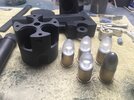
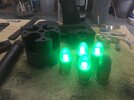
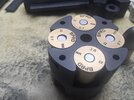
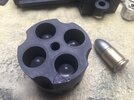
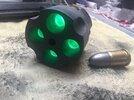
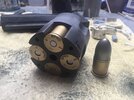
At this point, I drilled out a route for the laser sight wires to go from the little momentary switch under the trigger in the receiver frame through the main hinge of the gun, after advice from DaveChaos at TipTop as to the best way to do this. Note... I didn't drill through the internal resin bushing that fits inside the hinge and which the screws go into. Rather, I drilled an angled hole in the large barrel half of the gun, that carves out a hidden channel in the top of the hinge; this allows the wires to pass over the top of the bushing and into the space in the receiver frame on the other side of the hinge.
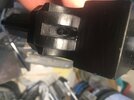
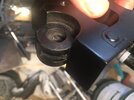
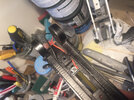
That done, on to the build of the gun, which involved quite a few iterations of putting together sub-assemblies to check for fit, taking them apart to refine and fettle things, re-assembling them etc etc...
The main parts of the gun are pressure cast resin (black in my case), with smaller details either resin printed or - as a brilliant bonus - cast in pewter. The kit comes with all the hardware - screws, brass pins, springs etc. - needed to assemble the gun, as well as the electronics to create the laser sight and four glowing tracker bullets (all you need to supply is 11 LR44 button cells - 2 for each of the bullets and 3 for the laser). The resin is beautifully cast, with little or no bubbles and requires minimal clean up of excess resin or flash. I started by giving all the parts a really good scrub with household degreaser and soapy water to get rid of any mould-release residue and let them air dry before the small amount of filing, filling and sanding needed to ready them for the next stage. Another quick wash and then a gentle wet-sanding with low grit sand paper finished them off nicely. I left the odd minor imperfection as I knew I was going to be adding damage later!
The picture shows the parts all laid out (I’ve already painted and assembled the bullets - see below).

Time for a first dry fit assembly. Damn! This thing is HUGE! (phaser for size reference - in case you assume from the first image that I have a Munchkin size hand)


The gun went together really well from the start, although, as you’d expect, there was some adjusting to be done, especially on the resin printed parts. So a bit of sanding and filing was needed at this stage to get the fit of the parts perfect - the tolerances are quite tight, and rightly so. Some experimentation, fitting and re-fitting, and a bit of work is needed to get the cylinder spinning freely, the bullets fitting into the cylinder easily and the various smaller detail parts perfectly attached. Certainly no more than you’d expect from resin printed parts, and all easily accomplished.
I decided to dip a toe into the water of this build by painting the bullets first, and getting their electronics installed. Each bullet comes in four parts, a resin printed casing and a tip that’s cast (really well) in clear resin, plus an internal housing for two LR44 button cells and a micro-switch, and a resin primer. There's also a green 5mm LED for each bullet. The tip and the casing screw together around the battery holder/LED and the primer fits into the casing end to act as an external switch to light the LED. The design of the internal housing is really very clever and you can put it all together without even having to use solder or wires, using the clear instructions that come with the kit. I opted to add a little bit more strength to mine by soldering the joints, and I ended up glueing the primers to the switches too for extra durability (I didn't want to lose the primers at any point!



I primed the casings and the primers, sprayed them both satin black, and then airbrushed Alclad Polished Brass over the casings and ’Stainless Steel’ on the primers.
Voila - four beautiful green glowing tracker rounds. I also painted the ‘bonus bullet’ that comes with the kit too - this one brass again plus Alclad ‘Steel’ for the tip.






At this point, I drilled out a route for the laser sight wires to go from the little momentary switch under the trigger in the receiver frame through the main hinge of the gun, after advice from DaveChaos at TipTop as to the best way to do this. Note... I didn't drill through the internal resin bushing that fits inside the hinge and which the screws go into. Rather, I drilled an angled hole in the large barrel half of the gun, that carves out a hidden channel in the top of the hinge; this allows the wires to pass over the top of the bushing and into the space in the receiver frame on the other side of the hinge.



That done, on to the build of the gun, which involved quite a few iterations of putting together sub-assemblies to check for fit, taking them apart to refine and fettle things, re-assembling them etc etc...
Last edited:

